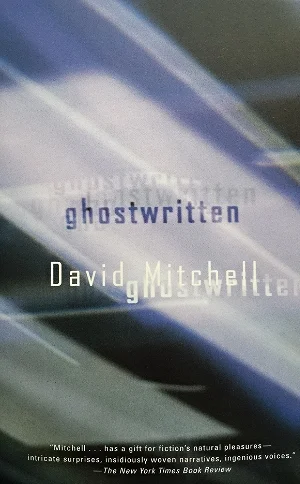David Mitchell continues to blow my mind. I have now read four of his seven published novels (the other three are in my possession and high on my TBR) and all of them have been four- or five-star reads. I recently finished his latest novel, Slade House, and immediately sent a copy to my mother for her birthday. She read it right away and said it kept her awake at night because it freaked her out so much. I did not quite have that reaction to it as I was more intrigued by the Slade House and was too consumed trying to figure out its puzzle to be afraid.
This is a different kind of haunted house story. There are no boo scares, no fanged monsters. I felt more of a gradually growing disquiet. Mitchell teases the reader along just as Slade House’s mysterious inhabitants tease new visitors into their grasp. The clues Mitchell presents are an irresistible trail of bread crumbs. Oddities are revealed at a perfectly measured pace, each one more bizarre than the last, each one building the intrigue until the reader is completely trapped in Mitchell’s clutches and has no choice but to give in to the madness.
Part of what makes David Mitchell so special to me is his diversity. His novels are contemporary fiction but some of them have traces of science fiction, historical fiction, or supernatural elements –and in the case of his superb Cloud Atlas, all of those are present. Slade House is a bit spooky, not quite horror, but definitely could share shelf space with the best of the genre. His characters are equally diverse. He writes men and women, children and the aged, multiple nationalities in such a way that I think he must be wonderfully observant, introspective, and in touch with humanity. I have yet to read one of Mitchell’s characters and feel they are inorganic. Each might as well be a real person.
As Mitchell has done with every novel he has written, he sneaks a character from a previous work into Slade House in what was for me a scintillating way. And who knows which of the characters in this novel will appear in a future work? I have said it before but I love that Mitchell does this. It adds a bit of a game layer to his novels that I enjoy. I find myself reading the story quite happily, immersed fully in the yarn and when I happen upon a familiar name, I stop to figure out in which book that character exists. My brain is then sent spinning as I consider all of the possibilities and repercussions of these two stories existing in the same literary universe. I must then reconsider everything I have read up to this point and ponder how the new novel’s events may affect or may have been affected by the events of the previous novels. It is a wonderfully immersive mental feast, the literary equivalent of filet mignon with a glass of Sangiovese.
Slade House is one of Mitchell’s shorter works. The American hardcover edition is a squat little yellow book 238 pages in length. Even a slow reader like me was able experience the full story in a short period of time. For readers who have not yet experienced David Mitchell, this is probably a great introduction to him. Reading the story will not be a huge time commitment, unlike one of his meatier pieces like The Bone Clocks or my beloved Cloud Atlas. The style of Slade House provides a new reader with a good look at how Mitchell constructs his stories, plays his characters, and tantalizes his audience. If you are already a fan of David Mitchell and have not yet read Slade House, I suspect you will not be disappointed. If you are curious about this brilliant author, give Slade House a try and then prepare to add his entire bibliography to your TBR.


